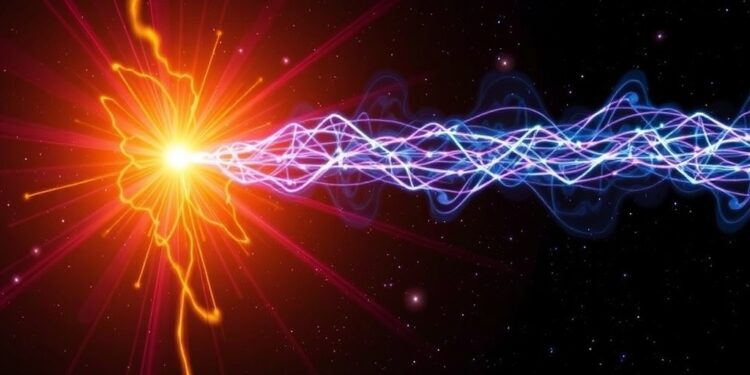
Ultrahigh Energy Cosmic Rays (UHECRs) stand as one of the most enigmatic phenomena in the cosmos. These particles carry energy levels that exceed a million times those produced by human technology, positioning them at the extreme end of the particle energy spectrum. Scientists have acknowledged the existence of UHECRs for over six decades, yet a comprehensive understanding of their origins has remained elusive. This ongoing mystery has led researchers down various theoretical paths, with many speculating about their possible sources but failing to develop a universally accepted explanation.
Recent advancements in astrophysics, however, have begun to illuminate the shadows surrounding UHECRs. A groundbreaking theory introduced by Glennys Farrar, a physicist from New York University, provides a promising explanation that could finally reveal the mechanisms behind the creation of these extraordinarily energetic particles. Farrar’s research represents a significant leap forward in astrophysical inquiry, integrating established theories with fresh observational data.
Farrar asserts that the origins of UHECRs are closely linked to the cataclysmic events that occur during binary neutron star mergers. These mergers, where two dense stellar remnants collide and combine, are not merely spectacular astronomical events; they are also pivotal to the synthesis of heavy elements, such as gold, platinum, and uranium. When these massive stars ultimately coalesce into a black hole, they express their violent transformation through a myriad of energetic outflows, nurturing the conditions necessary for the acceleration of UHECRs.
The mechanism proposed in Farrar’s work suggests that during these extreme astrophysical events, cosmic rays are catapulted into the universe within turbulent magnetic outflows that are produced in the aftermath of the merger. This revelation aligns well with our current understanding of gravitational waves, which have already been detected by the LIGO-Virgo collaboration, establishing a tangible connection between these formidable cosmic phenomena and the creation of UHECRs.
One of the striking aspects of Farrar’s theory is its ability to account for two long-standing puzzles regarding UHECRs. Firstly, it addresses the tight correlation observed between a UHECR’s energy and its electric charge, a relationship that had previously defied explanation. Secondly, the theory sheds light on the exceedingly high energy events that have been recorded, events that often seem to exceed the conventional limits of particle acceleration described by existing astrophysical models.
Due to the implications of this research, there are tangible avenues for experimental validation moving forward. The identification of very high-energy cosmic rays, particularly those that originate from specific heavy elements synthesized through rapid neutron capture processes (referred to as “r-process” elements), is one potential outcome from Farrar’s findings. Thus, the scientific community is urged to delve into existing UHECR data with a renewed perspective, focusing on potential r-process signatures such as xenon and tellurium.
Another exciting prospect stemming from this work is the potential detection of extremely high-energy neutrinos that could accompany the gravitational waves generated during neutron star mergers. As these energetic neutrinos share a causal relationship with the UHECRs produced in the same violent upheaval, their detection could serve as a crucial piece of evidence in discerning the origins of these cosmic rays and further validating Farrar’s theoretical framework.
In conclusion, the revelations stemming from Glennys Farrar’s research mark a significant stride in our understanding of the cosmos. By connecting the dots between binary neutron star mergers, gravitational waves, and ultrahigh energy cosmic rays, she has not only illuminated the origins of some of the universe’s most energetic particles but has also opened new pathways for exploration. The fusion of theoretical physics with observational data presents an unparalleled opportunity for discovery, as the scientific community rallies to explore the implications of these findings.
As researchers embark on this journey towards uncovering the mysteries of UHECRs, we stand on the precipice of potentially monumental discoveries in astrophysics. The next steps will undoubtedly involve collaborative efforts involving ground-based observatories and space telescopes, all aimed at refining our comprehension of the universe’s most energetic phenomena, ensuring that the legacy of these cosmic rays continues to captivate and inspire future generations of scientists.
Subject of Research: Ultrahigh Energy Cosmic Rays
Article Title: Binary Neutron Star Mergers as the Source of the Highest Energy Cosmic Rays
News Publication Date: 28-Feb-2025
Web References: Physical Review Letters
References: 10.1103/PhysRevLett.134.081003
Image Credits: Not applicable
Keywords
Cosmic rays, Binary neutron stars, Gravitational waves, Astrophysics, Neutron star mergers, UHECRs
Tags: astronomical phenomenaastrophysics advancementsbinary star collisionscataclysmic cosmic eventscosmic ray originsGlennys Farrar researchheavy element synthesisneutron star mergersparticle energy spectrumsources of high-energy particlestheoretical astrophysicsUltrahigh Energy Cosmic Rays





